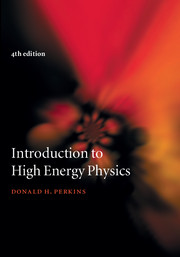Book contents
- Frontmatter
- Contents
- Preface
- 1 Quarks and leptons
- 2 Interactions and fields
- 3 Invariance principles and conservation laws
- 4 Quarks in hadrons
- 5 Lepton and quark scattering
- 6 Quark interactions and QCD
- 7 Weak interactions
- 8 Electroweak interactions and the Standard Model
- 9 Physics beyond the Standard Model
- 10 Particle physics and cosmology
- 11 Experimental methods
- Appendix A Table of elementary particles
- Appendix B Milestones in particle physics
- Appendix C Clebsch–Gordan coefficients and d-functions
- Appendix D Spherical harmonics, d-functions and Clebsch–Gordan coefficients
- Appendix E Relativistic normalisation of cross-sections and decay rates
- Glossary
- Answers to problems
- Bibliography
- References
- Index
11 - Experimental methods
Published online by Cambridge University Press: 05 June 2012
- Frontmatter
- Contents
- Preface
- 1 Quarks and leptons
- 2 Interactions and fields
- 3 Invariance principles and conservation laws
- 4 Quarks in hadrons
- 5 Lepton and quark scattering
- 6 Quark interactions and QCD
- 7 Weak interactions
- 8 Electroweak interactions and the Standard Model
- 9 Physics beyond the Standard Model
- 10 Particle physics and cosmology
- 11 Experimental methods
- Appendix A Table of elementary particles
- Appendix B Milestones in particle physics
- Appendix C Clebsch–Gordan coefficients and d-functions
- Appendix D Spherical harmonics, d-functions and Clebsch–Gordan coefficients
- Appendix E Relativistic normalisation of cross-sections and decay rates
- Glossary
- Answers to problems
- Bibliography
- References
- Index
Summary
Accelerators
All accelerators employ electric fields to accelerate stable charged particles (electrons, protons, or heavier ions) to high energies. The simplest machine would be a d.c. high-voltage source (called a Van der Graaff accelerator), which can, however, only achieve beam energies of about 20 MeV. To do better, one has to employ a high frequency a.c. voltage and carefully time a bunch of particles to obtain a succession of accelerating kicks. This is done in the linear accelerator, with a succession of accelerating elements (called drift tubes) in line, or by arranging for the particles to traverse a single (radio-frequency) voltage source repeatedly, as in the cyclic accelerator.
Linear accelerators (linacs)
Figure 11.1 shows a sketch of a proton linac. It consists of an evacuated pipe containing a set of metal drift tubes, with alternate tubes attached to either side of a radio-frequency voltage. The proton (hydrogen ion) source is continuous, but only those protons inside a certain time bunch will be accelerated. Such protons traverse the gap between successive tubes when the field is from left to right, and are inside a tube (therefore in a field-free region) when the voltage changes sign. If the increase in length of each tube along the accelerator is correctly chosen then as the proton velocity increases under acceleration the protons in a bunch receive a continuous acceleration. Typical fields are a few MeV per metre of length. Such proton linacs, reaching energies of 50 MeV or so, are used as injectors for the later stages of cyclic accelerators.
Information
- Type
- Chapter
- Information
- Introduction to High Energy Physics , pp. 338 - 376Publisher: Cambridge University PressPrint publication year: 2000
